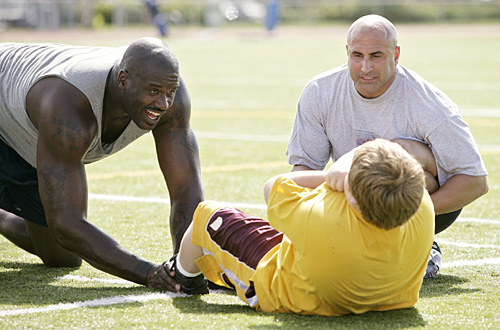1. Make sure your kids have a proper breakfast.
Breakfast sets the stage for the rest of the day. It gives a child the needed energy to pay attention in school and tackle the day. Cutting back here is a big mistake. Don’t let your kid rush out the door with a can of soda and bag of chips. A proper breakfast is filled with good proteins like eggs and low-fat milk, healthy carbohydrates like oats and whole grains, and vitamins like grapefruits and berries.
2. Shop healthy.
Buying organic food is great but it can break your budget. With a little practice, smart shopping at a regular grocery store is more than satisfactory. They key is to buy as much fresh, perishable, and unpackaged food as possible. Lean away from plastic sealed, pre-packaged, preservative and chemical-laden foods. Read ingredient labels and if the contents sound too complicated, it’s probably not a healthy choice for your family.
3. Cook food at home whenever possible.
Busy lifestyles and tight budgets have practically pushed food preparation into extinction. In its place are fast food restaurants where it’s all about the cheapest ingredients, high fat, and deep frying. The fact is preparing food fresh from scratch is the healthiest way plus it’s an activity the whole family can participate in and have fun with.
4. Make sure you know what your kid is eating at school.
Lunch meals are a big part of a child’s day. Knowing what they are eating and putting in their bodies is critical to their health. Be sure you take a little time to find out and if you don’t like what you see, be a squeaky hinge and try to push for healthy changes. If you feel powerless, know you are not alone. Band together with other interested parents and create an independent parent group that oversees what the schools are feeding your children.
5. Teach your kids to snack smart.
Kids love to snack. Candies and pre-packaged sweet baked goods are not healthy but having them once in a while is not the end of the world and almost unavoidable. The trick is to educate your kids on healthier snack choices and, whenever possible, prepare some to take with them to school. Snacks like fresh fruit (apples, bananas, pears, peaches, etc.), trail-mix (nuts, raisins, dates, figs, etc.), yogurt, celery with peanut butter, and carrot sticks with salad dressing, are just a few of the many possibilities.
6. Encourage kids to join in after school athletics.
Schools are filled with opportunity to join in team and intramural sports like basketball, football, soccer baseball, and others. Girls have soccer, field hockey, cheerleading, and others. Even joining the marching band is great physical activity for your child. Just be sure to try and be as much a part of the experience as possible right there with them. Make it to as many games as possible and cheer them on.
7. Where schools come up short, look to community center activities.
Community centers like the Boys and Girls Clubs of America and the YMCA have terrific after school activities like swimming, gymnastics, martial arts, and among many others. The supervision is excellent and their fees are usually quite reasonable.
8. Kids should be outside when the weather is nice.
Too many kids turn into lumps on the coach staring at the TV and not moving. When the sun is shining and the weather is nice, they should be encouraged to play outside. Establish a household policy and find a safe play area outside along with friends and neighbors just like you. Establish fun outdoor games for them to play and join in whenever possible.
9. Encourage kids to have little physical “jobs” to get done every day.
This encourages an active and physical life from early on and can begin at a surprisingly young age. To earn allowance, extra pay, or simply to be part of the family unit, kids should have a clear set of physical activities they need to accomplish as part of their day. Taking out the garbage, setting the table for dinner, cleaning up after dinner, walking the dog, cleaning up after the cat, and picking up after themselves are all examples.
10. Have a family fitness time.
A planned family fitness time where everyone participates in an activity that has everyone up and out of their chairs is a great way to encourage a healthy lifestyle. Even once each week can make a big difference. Family fitness time can be as complex as a softball game in the park or as simple as a bike ride, hike, or long walk. Even a game of musical chairs which does not even require leaving the house qualifies nicely.
11. Encourage the sporting life.
Find out what your child is interested in that requires physical activity and encourage them. Often overlooked activities as simple as skipping rope, playing hop-scotch, skateboarding, playing catch, or just about anything else your child is excited about is fair game. As a parent, being excited and entertained by your child’s participation in these types of activities underscores for them the importance and makes them love it even more.
12. Try and have a structured bed time.
Poor sleeping habits and inconsistent bed-times are a pre-requisite to low physical activity, poor school performance, and bad health. You can’t expect your kids to have a healthy physical lifestyle when they are tired all the time. Younger kids should go to bed at or near the same time each night, while older kids should have a rigid curfew.
13. Be physically competitive.
Kids love to compete against their siblings, but it’s especially fun with they can try and out-do mom or dad. There are few things more motivating than healthy competition. It’s human nature to try and rise to a challenge. Set aside some time to see how many push-ups or sit-ups everyone can do. Make a chart, set some goals for each individual, and crown a monthly champion!
14. Make sure gym class is part of your child’s curriculum at school.
Too many schools have pushed aside gym and made it non-mandatory for children in response to the pressures on the schools to push the kids toward better grades and test scores. The problem is that this goes directly against the scientific facts that physically active children do better in school. Don’t let your school get away with it. Find out what’s going on there and get involved, making sure that every child gets the essential time to let loose, run, jump, and play.
15. Lead by example.
Finally, you must understand your own role in the healthy development of your child. As parents we are the first and most important role models for our children. Many times we fail to fully appreciate this fact. As such, it is essential that we lead by example. We can’t expect our children to make healthy food choices and be physically active if we don’t practice what we preach.








